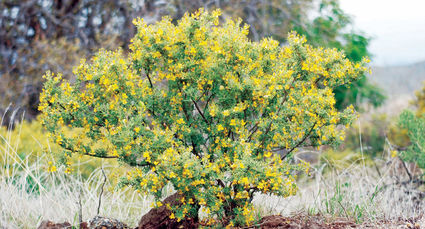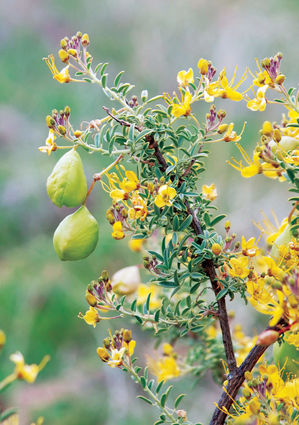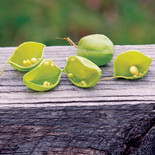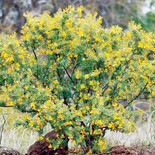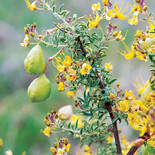Bladderpod: a unique and incredibly tough shrub you've seen but didn't notice
Land of Four Seasons
February 15, 2020
While driving home from Bakersfield on the back way (Bena Road) between Edison and the Arvin Cutoff this week, I noticed that the earliest wildflowers to bloom in our mountains were beginning to show their first yellow color. These unique and interesting plants are Bladderpods.
The extremely drought-tolerant Bladderpods begin flowering on the San Joaquin Valley floor, and then follow spring as it moves upslope. With egg-shaped green globes dangling from the stems, beautiful yellow flowers and intensely pungent foliage, the Bladderpod may be the most easily identifiable shrub in Kern County.
While other wildflowers often depend heavily on the whims of winter rains and may not make an appearance in a dry year, Bladderpod is an amazingly hardy shrub that blooms robustly regardless of our rainfall.
In bountiful seasons or even during prolonged drought, Bladderpod produces a profusion of attractive yellow flowers, year in and year out. It is one of the toughest shrubs in California, thriving from the desert to the coast, where it blooms and flourishes even where it gets misted with salt spray from the ocean. It is a remarkable plant, and makes a good choice as a rugged landscape plant for an extremely low maintenance garden.
Bladderpod is closely related to the caper bush, the plant whose berries and buds are salted and pickled and then used extensively in Mediterranean cuisine. Inside each of the light, air-filled pods are a small number of seeds. When the pods dry out, these globes hang like paper lanterns and the seeds rattle around inside. The shrubs typically grow from two to six feet tall, though most only reach four feet tall in our area.
The Nuwä (Kawaiisu or Paiute) Indian people of the Tehachapi area traditionally ate the yellow flowers of the Bladderpod, which is called süpütübä, pronounced suh-puh-TUB-ah, either boiled or roasted by placing on a hot rock and leaving overnight. The flowers reportedly have to be cooked for four hours to remove their bitter flavor and become sweet. After this some Native peoples mix the cooked flowers with sautéed onions and salt and eat them in a tortilla. The immature seeds can be eaten like green peas, though master forager Judith Larner Lowry, in her excellent book California Foraging, recommends boiling them for 15 minutes first to tame their strong flavor.

It is hard to imagine anyone nibbling on the foliage, however: it has a very strong odor, and in various sources I have found it described as "evil-smelling," "disagreeable" and "strongly unappetizing." I think that "evil-smelling" is a bit hyperbolic, but it's nothing that you'd want to rub on yourself before a date.
One rancher in our area stated in the 1950s that cattle would starve before they would eat Bladderpod, but Ernest Twisselmann has written that cattle in the Temblor Range would "commonly browse bladderpod freely and beneficially," even though it was the same species of plant. Twisselmann speculated that there must be an inexplicable difference in the taste of the plants grown in the two different areas.
Regardless of the pungency of the foliage, the flowers are beautiful and apparently provide ample nectar, for if you stand near a blooming Bladderpod you will encounter a steady stream of nectar feeders, including honeybees, bumblebees, hummingbirds and many others drawn to the four-petaled yellow flowers, whose six long yellow stamens rise up out of the flower cup like long-stemmed tulips stuck in an oversized vase.
Bladderpod was formerly known by the botanical name Isomeris arborea, but the name has been changed to Peritoma arborea. The variety found in our area is known as Valley Bladderpod, Peritoma arborea var. globosa, and the original specimen type was collected near Tehachapi by the famed botanist Frederick Vernon Colville on June 24, 1891 at Caliente Creek near Caliente.
Colville was a highly regarded plant specialist who later served for many years as Chief Botanist of the United States Department of Agriculture, and he was also instrumental in the development of commercial blueberry farming in the U.S. In addition, from 1920 to his death in 1937, he was chairman of the National Geographic Society's Research Committee and was instrumental in determining which projects the NGS would fund. I like to imagine Colville as he travelled the Tehachapi Mountains by horseback in the 1890s, collecting plant samples in our sparsely populated area of Kern County.
So look around as you drive down to Bakersfield, and you will see begin to see Bladderpod blooming now. It has started flowering at the lower elevations, and will continue now at least into April.
You have no doubt seen it before – many individual plants grow right alongside Highway 58 – but may not have realized how unique and resilient it was.
Enjoy the beauty of life in the Tehachapi Mountains.
Jon Hammond is a fourth generation Kern County resident who has photographed and written about the Tehachapi Mountains for 38 years. He lives on a farm his family started in 1921, and is a speaker of Nuwä, the Tehachapi Indian language. He can be reached at tehachapimtnlover@gmail.com.


